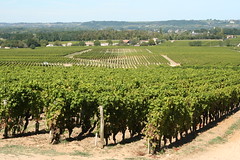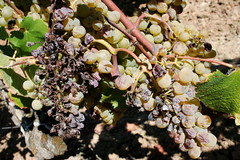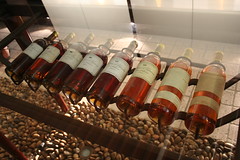 We spent a day in the sub-region of Sauternes, home of the greatest sweet wines in the world. We were welcomed at Château Doisy-Védrines by the owner Olivier Casteja for a tour the property and a lunch in his modest, 2-storey farmhouse. Doisy-Védrines is situated in Barsac, within the Sauternes appellation, and has been owned by the Casteja family for generations.
We spent a day in the sub-region of Sauternes, home of the greatest sweet wines in the world. We were welcomed at Château Doisy-Védrines by the owner Olivier Casteja for a tour the property and a lunch in his modest, 2-storey farmhouse. Doisy-Védrines is situated in Barsac, within the Sauternes appellation, and has been owned by the Casteja family for generations.  Olivier toured us through the vineyards, explaining the process with which they make their sweet wines. He highlighted their low yields, the effects of Botrytis rot on the grapes and the arduous hand-harvesting procedure that spans for weeks to months; each step essential to the final product. Our 5-course lunch was paired with Doisy wines, with vintages dating back to 1970. It was fascinating to experience how well the sweet wines paired with each course.
Olivier toured us through the vineyards, explaining the process with which they make their sweet wines. He highlighted their low yields, the effects of Botrytis rot on the grapes and the arduous hand-harvesting procedure that spans for weeks to months; each step essential to the final product. Our 5-course lunch was paired with Doisy wines, with vintages dating back to 1970. It was fascinating to experience how well the sweet wines paired with each course.
 The iconic Château d’Yquem is considered to produce the finest dessert wine in the world. During this rare opportunity to tour the property, we learned about the laborious process of making this exceptional wine. Sauternes is produced by grapes which have been attacked by a fungus called Botrytis cinerea, also known as Noble Rot, that partially raisinates the grapes.
The iconic Château d’Yquem is considered to produce the finest dessert wine in the world. During this rare opportunity to tour the property, we learned about the laborious process of making this exceptional wine. Sauternes is produced by grapes which have been attacked by a fungus called Botrytis cinerea, also known as Noble Rot, that partially raisinates the grapes.  A unique combination of weather is required in order for noble rot to take form (cool misty mornings followed by warm dry afternoons) otherwise grey rot will develop, spoiling the grapes. Hand harvested one grape at a time over multiple passes through the vineyard (up to 14 for d’Yquem), the production of this wine is not only painstaking, but also a gamble with nature, as some years, when the conditions are not ideal, no wine is produced. The wines are reflectively expensive.
A unique combination of weather is required in order for noble rot to take form (cool misty mornings followed by warm dry afternoons) otherwise grey rot will develop, spoiling the grapes. Hand harvested one grape at a time over multiple passes through the vineyard (up to 14 for d’Yquem), the production of this wine is not only painstaking, but also a gamble with nature, as some years, when the conditions are not ideal, no wine is produced. The wines are reflectively expensive.  However a good Sauternes is an experience like no other for the senses. This nectar is deep gold in colour, lusciously sweet yet zesty and fresh, with rich tropical and earthy aromas and flavours that linger in your mouth for a very long time.
However a good Sauternes is an experience like no other for the senses. This nectar is deep gold in colour, lusciously sweet yet zesty and fresh, with rich tropical and earthy aromas and flavours that linger in your mouth for a very long time.